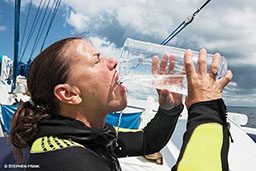Q: I’ve heard that deep vein thrombosis (DVT) is a concern for travelers on long flights. What are the risk factors for getting DVT, and will I still be able to dive if I do?
A: DVT is a condition in which a blood clot forms in one or more of the deep veins, usually in the legs. When blood clots break free and travel with the blood, DVT can cause life-threatening conditions such as stroke or pulmonary embolism. DVT is not related to diving, but divers often travel and are thus exposed to the risk of DVT.

Although DVT while traveling is rare (the prevalence for travelers on flights of more than eight hours is between 0.3 and 0.5 percent), risk factors include older age (with increasing risk after age 40), obesity, estrogen use, recent or current pregnancy, thrombophilia, prior personal or family histories of DVT, active cancer, serious illness, recent surgery, limited mobility, central venous catheterization and significantly above- or below-average height.
If you will be on a long flight and believe you might be at increased risk for DVT, you can reduce the likelihood of developing the condition by wearing compression socks and talking with your primary-care physician regarding the possible benefits of anti-inflammatory medications. It is also good practice to periodically stand up and walk around, exercise the feet and calves while you are seated and stay well-hydrated.
If you develop DVT, you should not dive during the acute phase of the condition or while you are taking anticoagulants. You may return to diving after DVT, but you should not do so before consulting a physician trained in dive medicine. It is less likely that you will be able to return to diving after pulmonary embolism, but you may be able to do so in consultation with a physician. Returning to diving after a stroke should also be evaluated on an individual basis.
— Petar Denoble, M.D., D.Sc.
Q: I recently went on a dive trip in which the staff insisted that we should all drink five to six liters (about 1.5 gallons) of water on dive days. Is this really a good idea?
A: This practice is not universal and not recommended. It is a natural human tendency to rationalize that if a small amount of something is good then a larger amount must be better, but that rationale seldom holds true. Consuming that much water could actually lead to serious medical problems.

One potential complication is “water intoxication,” a phenomenon in which excessive consumption of water leads to a decreased amount of sodium and other electrolytes outside of the body’s cells. The reduced sodium concentration outside the cells means the sodium levels within cells are relatively higher. Water will enter the cells to try to equilibrate the sodium levels, which causes them to swell. This in turn can cause skeletal and abdominal muscle cramping. Furthermore, swelling in the brain cells can result in confusion, personality changes, coordination problems and a lack of situational awareness. Severe, untreated cases of water intoxication can lead to coma and death.
Another potential complication for divers is an increase in the fluid volume of the blood. When we are submerged in water there is a shift in blood volume from the peripheral vessels to the central circulation. This is expected and normal. Typically when this blood shift occurs the heart’s contractile force increases accordingly to compensate, but an abnormally high blood volume can overwhelm cardiac function in some individuals. This leads to immersion pulmonary edema (IPE), which can develop on the surface, during a dive or immediately after surfacing. Essentially the body’s own fluids accumulate in the lungs, causing acute shortness of breath and potential loss of consciousness. Depending on the severity of symptoms, the person may require anything from supportive care to aggressive intervention by medical professionals.
The potential complications of excessive hydration outweigh any perceived benefit. Adequate hydration is important, but there are no data that demonstrate that divers need to significantly increase their fluid intake. Be skeptical of bold proclamations, and do not hesitate to ask for sources of such recommendations.
— Marty McCafferty, EMT-P, DMT
Q: I will be testing equipment in a series of two 60-minute dives to 10 feet (3 meters) at an altitude of 5,400 feet (1,646 m). The following day I will ascend to a maximum altitude of 11,570 feet (3,527 m) for a skiing trip. Is it safe to drive to a high altitude after my dives?
A: You get credit for thinking in advance about the issue of ascent to altitude after diving. While easily forgotten in dive planning, it can be a significant problem depending on the dive(s) and altitudes.

Generally speaking, it is best to avoid altitude exposure, either through ground travel or flying, soon after diving. The current DAN guidelines for flying after diving recommend a minimum preflight surface interval of 12 hours after a single dive within no-decompression limits, 18 hours after multiple dive days or multiple sequential days of diving, and “substantially longer” than 18 hours after decompression dives.1 The exposure altitude covered by these guidelines is between 2,000 and 8,000 feet (610 and 2,438 m). Altitude changes of less than 2,000 feet are ignored in the belief that the pressure change fits within the normal variability of meteorological pressure. The majority of available data do not address travel to altitudes greater than 8,000 feet, but it certainly represents a greater degree of decompression stress.
The dive exposures you describe, however, are modest enough that it is useful to refer to the U.S. Navy altitude tables.2 They were constructed mathematically to consider specific dive profiles in the calculation of altitude exposure limits. The U.S. Standard Atmosphere3 describes the ambient pressure at 5,400 feet altitude as 12.05 psi. The “equivalent depth” (which is necessary when using standard tables that are based on sea-level diving) is computed by multiplying the actual dive depth by the atmospheric pressure at the exposure altitude, then dividing by the normal sea-level pressure assumed for the tables. The equivalent depth is thus 10 feet x 12.05 psi/ 14.7 psi = 8.3 feet. The equivalent depth for a 15-foot actual dive depth is 12.3 feet and for a 20-foot actual dive depth is 16.4 feet. Given the rules of rounding up with dive tables, there is effectively no change in the depths used for the computation of repetitive groups. (Note: This would not hold true for deeper dives.)
The U.S. Navy Revision 6 Table 9-7 places a diver completing a dive to 10 feet for between 102 and 158 minutes in repetitive group C. Diving to 15 feet (5 m) for between 121 and 163 minutes would put the diver in repetitive group E. Diving to 20 feet (6 m) for between 106 and 133 minutes would put the diver in repetitive group F. The altitude change from the lowest to highest point of travel you reported is just less than 6,200 feet (1,890 m). Table 9-6 does not restrict a 7,000-foot (2,134 m) climb in altitude for repetitive groups A-D. The minimum surface interval to precede travel is one hour and 37 minutes for repetitive group E, four hours and four minutes for F and six hours and 10 minutes for G.
Assuming the dives are conducted as planned and the travel takes place the next day (likely more than six hours later), there should be minimal risk of decompression sickness resulting from the diving. There are two points worth noting for those being exposed to altitude after diving. First, the 10-foot depth involved in your case is highly unusual. More typical diving exposures would warrant longer surface intervals before travel. The second point is that while the U.S. Navy tables give seemingly precise schedules, they do not consider the myriad factors that can alter the risk of decompression sickness. It is important to maintain the mindset of prevention by building in additional safety factors wherever feasible.
— Neal Pollock, Ph.D.
References
- Sheffield PJ, Vann RD, eds. Flying After Recreational Diving Workshop Proceedings. Durham, N.C.: Divers Alert Network, 2004.
- U.S. Navy Diving Manual, Vol. 2, Rev. 6. NAVSEA 0910-LP-106-0957. U.S. Naval Sea Systems Command: Washington, D.C., 2008: Chapter 9.
- U.S. Standard Atmosphere, 1976. National Oceanic and Atmospheric Administration, National Aeronautics and Space Administration, and United States Air Force. NOAA-S/T 76-1562. U.S. Government Printing Office: Washington, D.C., 1976; 227 pp.
Ask Us!
The DAN Medical Information Line is here to answer all your dive-related medical questions. You can reach the medical staff during regular business hours (Monday through Friday, 9 a.m. to 5 p.m. ET) by calling +1-919-684-2948, ext. 222. You can also submit an email at DAN.org/contact.
© Alert Diver — Q4 Fall 2014